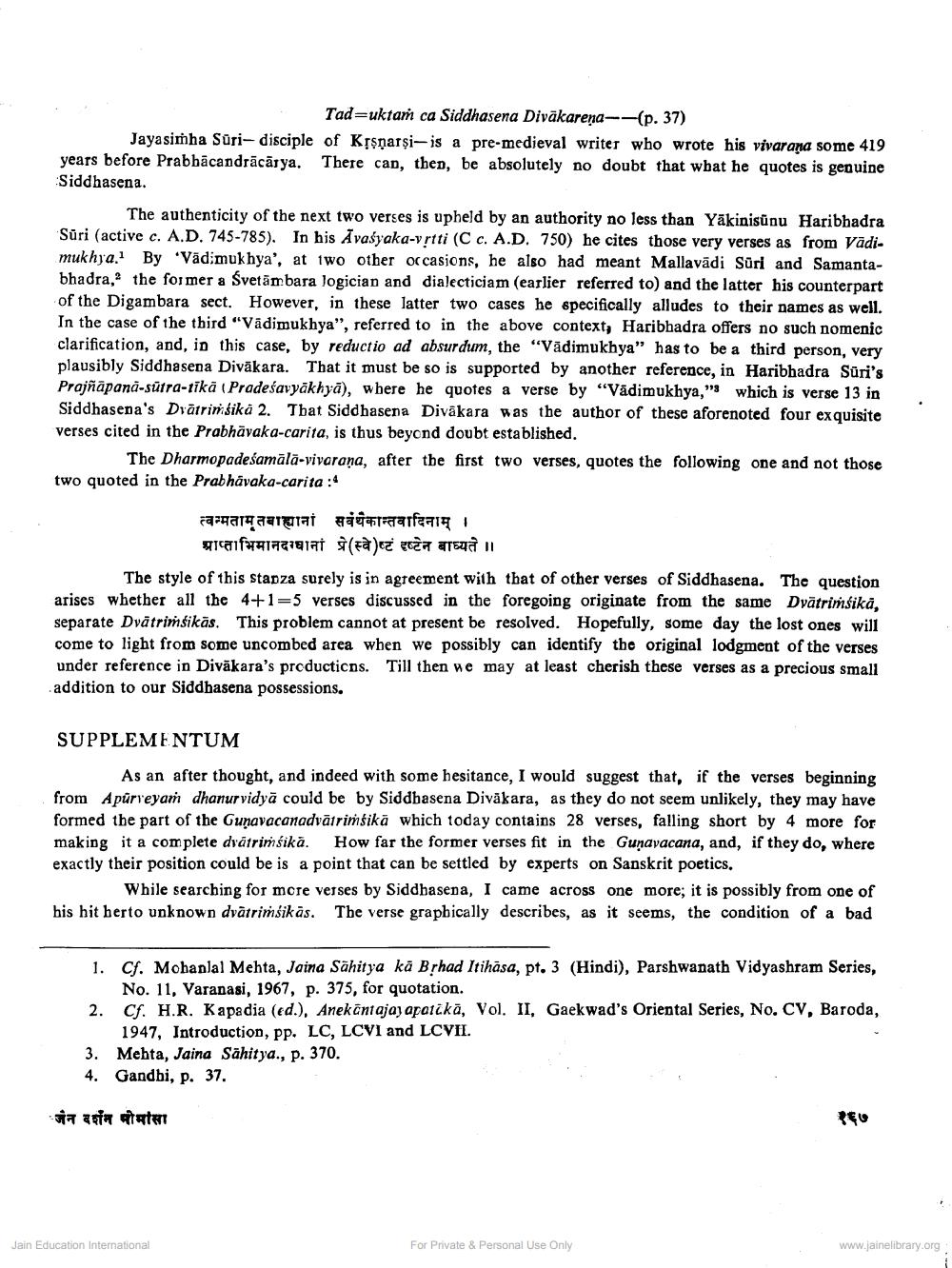Book Title: Some less known verses of Siddhasena Divakara Author(s): M A Dhaky Publisher: Z_Deshbhushanji_Maharaj_Abhinandan_Granth_012045.pdf View full book textPage 3
________________ Tad=uktań ca Siddhasena Diväkarena--(p. 37) Jayasimha Süri-disciple of Kļş arşi-is a pre-medieval writer who wrote his vivarana some 419 years before Prabbācandrācārya. There can, then, be absolutely no doubt that wbat he quotes is genuine Siddhasena. The authenticity of the next two verses is upheld by an authority no less than Yakinisūnu Haribhadra Sūri (active c. A.D. 745-785). In his Āvašyaka-vrtti (C c. A.D. 750) he cites those very verses as from Vadimukhya. By "Vädimukhya', at two other occasions, he also had meant Mallavādi Suri and Samantabhadra, the former a Svetām bara logician and dialecticiam (earlier referred to) and the latter his counterpart of the Digambara sect. However, in these latter two cases he specifically alludes to their names as well. In the case of the third "Vadimukhya", referred to in the above context, Haribhadra offers no such nomenic clarification, and, in this case, by reductio ad absurdum, the "Vādimukhya" has to be a third person, very plausibly Siddhasena Divākara. That it must be so is supported by another reference, in Haribhadra Sūri's Prajñāpanā-sūtra-tikā (Pradeśavyākhyā), where he quotes a verse by "Vadimukhya," which is verse 13 in Siddhasena's Dātrinsikå 2. That Siddhasena Divākara was the author of these aforenoted four exquisite verses cited in the Prabhāvaka-carita, is thus beyond doubt established. The Dharmopadešamālā-vivarana, after the first two verses, quotes the following one and not those two quoted in the Prabhāvaka-carita : त्वन्मतामतबाह्यानां सर्वथैकान्तवादिनाम् । graf#19019191 (a)ez acea aruã II The style of this stanza surely is in agreement with that of other verses of Siddhasena. The question arises whether all the 4+1=5 verses discussed in the foregoing originate from the same Dvātrinsika, separate Dvätriṁsikās. This problem cannot at present be resolved. Hopefully, some day the lost ones will come to light from some uncombed area when we possibly can identify the original lodgment of the verses under reference in Divākara's productions. Till then we may at least cherish these verses as a precious small addition to our Siddhasena possessions. SUPPLEMENTUM As an after thought, and indeed with some hesitance, I would suggest that, if the verses beginning from A pürreyaṁ dhanur vidyā could be by Siddhasena Divākara, as they do not seem unlikely, they may have formed the part of the Gunavacanadvātrimśikā which today contains 28 verses, falling short by 4 more for making it a complete dvātrimśikā. How far the former verses fit in the Gunavacana, and, if they do, where exactly their position could be is a point that can be settled by experts on Sanskrit poetics. While searching for more verses by Siddhasena, I came across one more; it is possibly from one of his hit herto unknown dvätrimśikās. The verse graphically describes, as it seems, the condition of a bad 1. Cf. Mohanlal Mehta, Jaina Sāhitya kā Brhad Itihāsa, pt. 3 (Hindi), Parshwanath Vidyashram Series, No. 11, Varanasi, 1967, p. 375, for quotation. 2. Cf. H.R. Kapadia (ed.), Anekantajaj apatikā, Vol. II, Gaekwad's Oriental Series, No. CV, Baroda, 1947, Introduction, pp. LC, LCVI and LCVII. 3. Mehta, Jaina Sahitya., p. 370. 4. Gandbi, p. 37. जैन दर्शन मीमांसा Jain Education International For Private & Personal Use Only www.jainelibrary.orgPage Navigation
1 2 3 4
